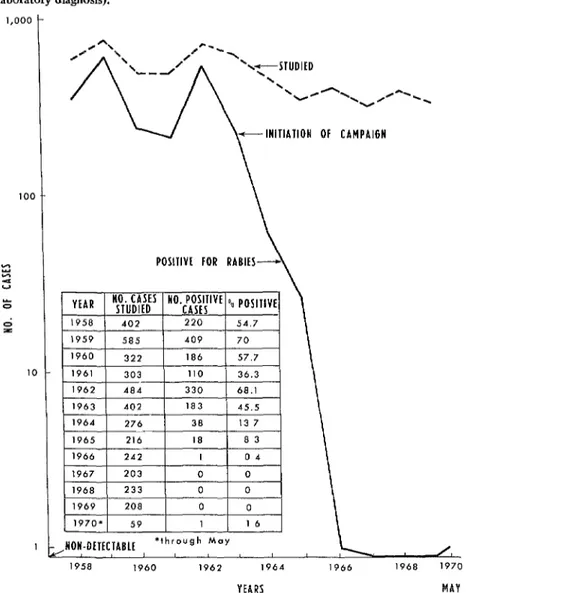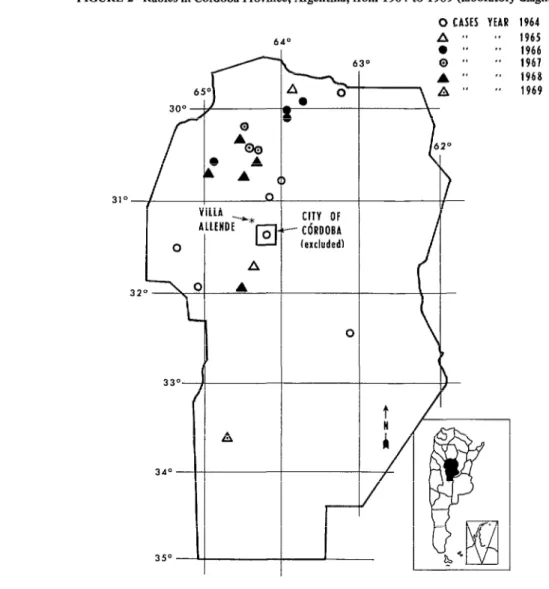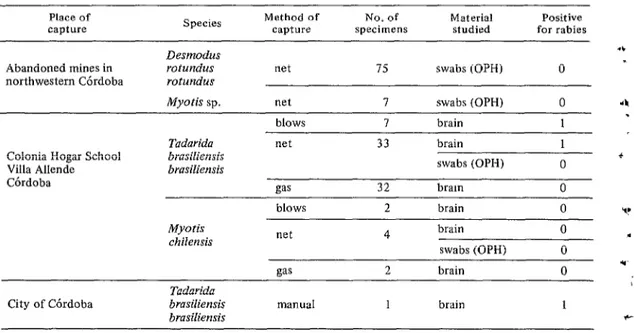S. Sileoni,2 0. Rossetti,2 A. M5rquez,3 A. C. Menoyo14 and R. A. de Torres’
The detection of rabies infection in insectivorous bats captured in Cbrdoba, Argentina, is creating new epide- miological problems for that city, where urban rabies has been under control since 1966.
Introduction
Much interest has been shown since 1958 in the epidemiology of rabies in the Province of Grdoba, especially because of the large endemic focus of canine rabies which then existed in the capital of the province.
One of the authors of the study described here worked with Dr. Jos& M. Vanella at the Institute of Virology, Cbrdoba, on a project for detecting rabies in wild animals. Many hema- tophagous Chiroptera or “vampire bats” (Desmodus rotundus rotundus) and other wild mammals in the northern part of the province and around the city of C6rdoba were studied by Sellers’ method, and attempts were made to isolate the virus in adult mice. The results were negative.
No evidence of sylvatic rabies was found, but interesting data were collected on the geographic distribution of hematophagous Chiroptera in Grdoba Province (1, 2).
lStudy carried out in the Antirabies Department, Undersecretariat of Public Health, Ministry of Social Welfare, Cbrdoba, Argentina. This paper was presented at the Argentine Virology Society in June 1970, and subsequently published in Spanish in Boletin de la Oficina Sanitaria Panamericana, Vol.LXX, No.5 (May 1971), pp.456-462.
ZContractual researchers, Antirabies Department, Undersecretariat of Public Health, Grdoba, Argen- tina.
3Assistant Director, Institute of Virology of C6r- doba: Associate Professor, School of Medical Sciences, Nat&al University of C6rdoba.
4Director, Antirabies Department, Undersecretariat of Public Health, Ckdoba, Argentina.
SAssociate Professor, Institute of Virology of Cbrdobai School of Medical Sciences, National Univer- sity of Cordoba.
Up to 1963 the incidence of rabies in dogs in the city of C6rdoba was high and there were occasional cases of human rabies. In 1963 Dr. Vanella planned and conducted an antirabies campaign and succeeded in controlling rabies in the city.
Because of outbreaks of canine rabies in 1967-1968 in rural areas in the northeast of the province, in Ischilin Department, in 1969 a program of epidemiological surveillance and investigation of rabies was started. Among its aims was the important one of looking for sylvatic rabies.
The present article describes and discusses some of the epidemiological aspects of rabies in Grdoba, and in particular the findings of the investigation of rabies in Chiroptera.
Materials and Methods
Direct Immunofluorescence Test
The method described by Goldwasser and Kissling was used (3, 4). The fluorescent anti- rabies conjugate, which had a titer of 1 :80, was provided by the Pan American Zoonoses Center. Observations were made with a Zeiss RA microscope, using an HBO-200 W/4 lamp, a 3 mm UC-1 excitation filter, a 41 barrier filter, and a darkfield condenser.
Vir~4s Isolation
Attempts were made to isolate virus in newborn Swiss albino mice (l-3 days old).
Twenty per cent suspensions of Chiroptera brain were prepared in distilled water contain- ing 2 mg of streptomycin and 500 units of penicillin per ml.
Oropharyngeal swabbings (OPH) were obtained with sterile rayon fiber swabs on wooden sticks. After vigorous swabbing of the buccal and pharyngeal surface, the swab was immersed in 1 ml of a diluent, consisting of distilled water with 1 per cent bovine albumin at pH 8.4-8.6, regulated with NaOH.
The mice were inoculated intracerebrally and observed for a period of not less than 30 days.
Neutralization Test to identify the Rabies Virus Swiss albino mice 3-5 weeks old were used as the host system.
The virus preparations for identification consisted of 20 per cent mouse brain suspen- sions. As specific antirabies serum the supernate of hyperimmune ascitic fluid (SHAF) was used, prepared in mice by four intraperitoneal inoculations (one a week) of 0.5 ml of 20 per cent suspensions of CVS rabies virus-infected mouse brain. The suspensions had previously been exposed to ultraviolet light (a 30-watt germicidal lamp at a distance of 20 cm) for 5, 4, 3 and 1 minutes, respectively. Another week later the mice received a fifth injection of active CVS rabies virus at a titer higher than lo5 LD,, mixed in equal parts with a 10 per cent suspension in saline solution of ascitic cells from mice inoculated with Sarcoma 180 (5, 6). Before it was used, the SHAF was inacti- vated at 56OC for 30 minutes. The neutralizing titer for 50 LD,, of CVS rabies virus was
1:625. The supernate of normal ascitic fluid (SNAF), prepared by inoculating Sarcoma 180 cells into mice not previously immunized (normal), was used as a control.
Distilled water with 2 per cent of inactivated serum of normal mice was used as diluent.
The procedure employed in the neutraliza- tion test was as follows: to start with, duplicate loglo solutions of the 20 per cent suspensions of mouse brain inoculated with the agents to be
identified or with CVS virus were prepared. To the first series of dilutions was added an equal volume of SNAF and to the second an equal volume of SHAF; the mixtures were well shaken and incubated for 90 minutes at 37OC. Each dilution was then inoculated into groups of six mice, which were observed for 30 days. A neutralizing index equal to or greater than 50 was considered significant.
Findings
The epidemiological situation in regard to rabies in Cbrdoba can be gauged from the results obtained by our laboratory in recent years and described below. The laboratory is the province’s only diagnostic center. It should be pointed out that the last case of human rabies that occurred in Cordoba was in 1963. The cases of animal rabies in the city of Cordoba are shown in Figure 1. Until the antirabies campaign was begun, the number of positive diagnoses every year was over 100. After 1964, i.e., a year after the start of the antirabies campaign, a marked fall was observed, until by 1967 rabies virus was down to undetectable levels.
The 1966 case occurred in the Province of Buenos Aires. A dog was bitten by another dog with rabies, and was subsequently brought to the city of Cordoba. The case that occurred in May 1970 involved a cat; it will be analyzed later in relation to the discovery of rabies in insectivorous bats.
FIGURE l-Rabies in animals in the City of Grdoba, Argentina, from 1958 to 1970 (laboratory diagnosis).
I t
1959 585 409 70
1960 / 322 1 186 1 57.7
1961 303 110 36.3
1962 4ea 330 68.1
1963 402 183 45.5
1964 276 38 13 7
1965 216 I8 83
1966 242 I 04
1967 203 0 0
1968 233 0 0
1969 208 0 0
1970* 59 1 16
,NON-DETECTABLE I *through May 4
1958 1960 1962 1964 1966 1968 1970
YEARS MAY
Table 1 shows the findings of the research carried out on Chiroptera in the period between August 1969 and May 1970. Negative results were obtained in a study of 75 hematophagous Chiroptera (Desmodus rotundus rotundus) and seven insectivorous Chiroptera (Myotis sp.) captured in the galleries of old abandoned minks in the northwestern part of the province. Part of this study was carried out with advice from Dr. Merle Kiins, of the Pan American Zoonoses Center, and with the participation of Mr. Gustav0 Bronstein.
At the beginning of 1970 a group of
biologists described how they had observed a large number of dead bats in a colony of insectivorous Chiroptera. The colony, living in the loft of an old building used as a school- house, numbered 500 to 1,000 bats. Eighty specimens were studied, 72 being classified as Tadarida brasiliensis brasiliensis and eight as Myotis chilensis.6 Rabies was found in two of
the bats belonging to the species Tadarida 6The taxonomic operation wn$ carried out by Dr. Mercedes Gutidrrez and verified by Dr. Jorge Crespo, of the Argentine Natural Scrences Museum. Their collaboration is gratefully acknowledged.
FIGURE 2-Rabies in C6rdoba Province, Argentina, from 1964 to 1969 (laboratory diagnosis). 0 CASES YEAR 1964
310
I
VILLAblLENDE-* cl 0 0
-,
32’= C
330-
340 -
350 -
A
CITY
OF
- CdRDOBA (ercludedl
brasiliensis brasiliensis. In April 1970 rabies was detected in another specimen of the same species captured in the city of Cordoba. The bat was found by its captor on the ground near the entrance to his home. It allowed itself to be captured without a struggle, then bit him on the thumb. He was given prophylactic treat- ment against rabies.
Rabies infection in the three bats was shown by:
(1) the presence of Negri bodies in brain impressions (Sellers’ method);
1965 1966 1967 1968 1969
(2) the specific fluorescence of simultaneous impressions studied by the direct fluorescent antibody technique;
(3) the death of newborn and adult mice inoculated with bat brain suspensions (incuba- tion period 7-9 days for newborn mice and 8-13 days for adult mice);
(4) the specific fluorescence of impressions prepared from the brain of mice killed by inoculation of bat brain suspensions;
TABLE l-Investigation of rabies in Chiroptera in Cbrdoba, Argentina, August 1969-May 1970. Place of
capture Species Method of capture specimens No. of Material studied for Positive rabies Abandoned mines in
northwestern C6rdoba
Desmodus rotundus rotundus Myotis sp.
Colonia Hogar School Villa Allende Cbrdoba
Tadarida brasiliensis brasiliensis
net 15 swabs (OPH) 0
net blows net
I swabs (OPH) 0
I brain 1
33 brain 1
swabs (OPH) 0
gas 32 brain 0
Myotis chilensis
blows net
2 brain 0
4 brain 0
swabs (OPH) 0
gas
2 brain 0City of C6rdoba brasiliensis Tadarida
brasiliensis manual 1 brain 1
Discussion
No concrete references have been found indicating the importance of insectivorous bat infection in initiating or maintaining urban (canine) rabies. It is possible that the explana- tion of some cases of rabies in cats, such as the one that occurred in May 1970, is that the cats had eaten or otherwise had direct contact with infected bats. At any rate, infection in Chirop- tera in urban areas is at least a potential danger that must be taken into account. It is not known whether the bats in the colony studied or those colonizing the center and outskirts of the city of Cordoba are migratory.
The plan of action to deal with the problem of rabies in Cordoba is to give protection to not less than 80 per cent of the canine population by vaccination and to maintain a diagnostic and preventive treatment center for persons bitten, while carrying out a program of epidemiological surveillance. All these programs come under the Undersecretariat of Public Health of the province. There is also a long-term dog-catching program, which is the responsibility of the municipality.
The discovery of infected Tadarida in the center and outskirts of the city calls for a new policy. It has been suggested that the health education of the population should be inten- sified to bring home the fact that the bite of any animal, including a bat, carries a risk of rabies. The study of other colonies of bats has also been begun, with a view to rounding off our present knowledge. The fact that rabies has been discovered has not been widely publicized in case there should be a panic reaction in the population that might lead to indiscriminate killing of bats, with ecological results that at present seem unpredictable. If infection were found to have spread to the majority of the bat populations in the city, it would probably be necessary to abandon the idea of eradicating rabies in Cordoba and deal with the problem by instituting control measures for an indefinite period, so as to avoid possible outbreaks in cats and dogs and the potential risk of transmission to human beings.
aim of developing a national scientific method- ology for controlling this source of rabies virus.
Summary
The annual total of cases of canine rabies in the city of C6rdoba has dropped from over 100 in 1963 to virtually nil since 1967 as a result of an antirabies campaign carried out by the Undersecretariat of Public Health of the province. The provincial authorities inoculate
dogs and effectively maintain a rabies surveil- lance and research service.
New impetus for intensifying all aspects of the campaign is provided by the discovery of rabies infection in bats captured in the green belt surrounding the city of C6rdoba.
The article describes some of the epidemi- ological aspects of rabies in C6rdoba and the results of an investigation carried out to ascertain the part, if any, played by Chiroptera in the incidence of rabies. The results were not conclusive, but sufficient evidence was found to warrant further ecological studies on bats. 0
REFERENCES
(I) Vanella, J. M., J. A. Crespo, and B. M. Blood. “Ampliacibn de la distribucibn geogrifica de1 vampiro en la Argentina.” Revistu de1 Minis- terio de Salud PLiblica y Asistencia Social (Province of Cbrdoba, Argentina) 4:17-19, 1959.
(2) Crespo, J. A., J. M. Vanella, B. M. Blood, and J. M. de Carlo. “Observaciones ecol6gicas de1
Antigens.” In: Proceedings of the Society for
Experimental Biology and Medicine-No. 98:219-223, 1958.
(4) Goldwasser, R. A., R. E. Kissling, R. T. Carsky,, and T. S. Hosty. “Fluorescent Antibody Staining of Rabies Viius Antigens in the Sali- vary Glands of Rabid Animals.” Bull WHO 20: 579-588, 1959.
vampiro Desmodus rotundus rotundus (5) Tikasingh, E. S., L. Spence, and W. G. Downs. (Geoffrov) en el norte de C6rdoba”. Revista del “The Use of Adiuvant and Sarcoma 180 Cells in kuseo A-rgentino de Ciencias Naturales “Ber- the Production -of Mouse Hyperimmune Ascitic nardino Rivadavia” e Instituto National de Fluid to the Arboviruses.” Amer J Trop Med Investigaciones de las Ciencias Naturales. Vol. 15:219-226, 1966.
IV, No. 4, 131-160, 1961. Buenos Aires, (6) Sartorelli, A. C., D. S. Fisher, and W. G. Downs.
Argentina. “Use of Sarcoma 18O/TG to Prepare Hyper-


